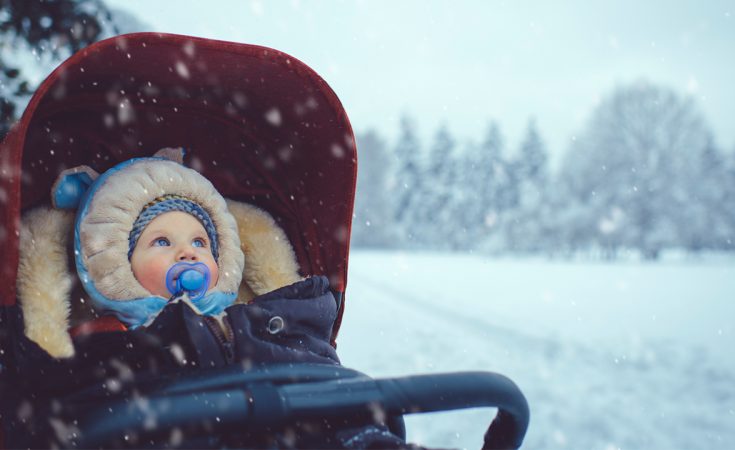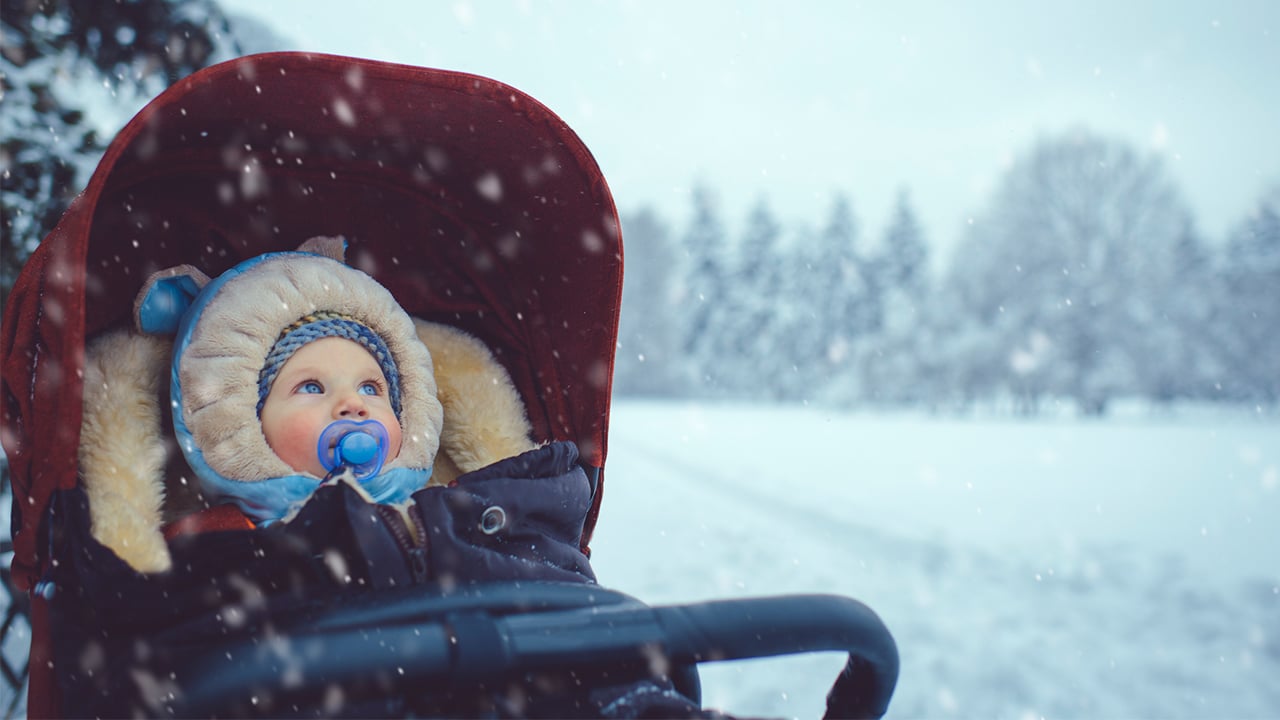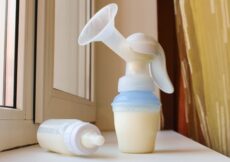You’ve mustered up the courage to take your peanut out in the cold, but what should she wear? Here’s how to keep your baby warm in the winter.
Jenny Berthiaume’sdaughter, Amie, was born during a Montreal winter, and the first-time mom quickly became an expert in dressing a newborn for seriously cold weather. “There are lots of things about Canadian winters that are inconvenient, and one of those is leaving the house with a baby. But you have to do it, both practically and for your well-being,” she says. We take the guesswork out of how to dress baby in winter.
In the car seat
First thing’s first: Bulky clothes, including puffy snowsuits, are not safe for car seats. “If there’s too much bulk, you’re not getting the harness tight enough,” explains Kelly Drury Laffin, a recently retired car seat technician in Edmonton. Instead, she suggests putting your baby in a sleeper (or well-fitted fleece suit) and a hat, buckling her in and placing blankets over top, being careful not to cover her face. Products that line car seats and act as sleeping bags to keep a baby warm in the winter are not safe because they interfere with the harness. If you want to buy something to cover the seat, opt for a shower-cap-style bag that goes right over top and has an opening for the baby’s face, says Drury Laffin.
In a carrier
Heading out with your infant in a carrier can be über-convenient in the summer, but it requires a bit more thought in the winter. “What’s of utmost importance is keeping baby’s airway clear, so that means they’re not chin to chest, their face is uncovered, and the parent is able to observe them,” says Drury Laffin, who is also a co-founder of the Canadian Babywearing School. The best-case scenario would be to have your baby dressed in a sleeper or something similar, strapped into the carrier next to your clothing with a babywearing coat covering you both. If you don’t have a babywearing coat, Montreal babywearing consultant Amy Ma suggests getting an extender panel that zips into your coat, and emphasizes that your coat should never be zipped up higher than the base of a baby’s neck, so that the head and face are never covered. Avoid big, chunky scarves, as they can obstruct the baby’s breathing.
Drury Laffin says parents can dress baby in winter with a hat and snowsuit, and then put the carrier on over their own coat, but all that bulk may be uncomfortable for you and make it harder to tell how your baby is doing. If you go this route, be extra careful to keep your baby’s airway clear and check his hands and feet often to be sure they are warm enough. This technique also makes it harder to take your own coat off if you go indoors, and if your baby falls asleep, you’ll have to unbundle her at your destination and risk waking her up.
In a stroller
If you’re venturing out with a stroller, Catherine Pound, a paediatrician at the Children’s Hospital of Eastern Ontario, recommends dressing your baby in layers. Start with a long-sleeved onesie, pants and socks or a sleeper, and then add a sweater or zip-up sweatshirt and, finally, a snowsuit. Ears, hands and feet are most at risk for frostbite, she says, so make sure they’re well covered. Most snowsuits fold over babies’ hands, but if yours doesn’t, you’ll need to put mittens on. Sonia Verma, a mom in Hamilton, Ont., has a trick for keeping mittens on tiny hands: putting kids’ socks over them. “They go most of the way up a baby’s arms and fit snugly over poofy warm clothes, and they’re very hard to tug off,” she says. Don’t use mittens with strings or scarves, as they’re both strangling hazards. Once your babe is bundled in clothes and outerwear, you can also zip him into a cozy stroller bunting bag, which covers hands and feet, and can be opened up if you head indoors. (Or just tuck a blanket over your baby.)
Berthiaume, now a mom of two, says that while keeping a baby warm in the winter can seem daunting at first, it does get easier. “You just find your way of doing it, and it becomes second nature,” she says. And fear not, spring will come.
Expert tip
Catherine Pound, a paediatrician at the Children’s Hospital of Eastern Ontario, says if the temperature is -20C or below, you should limit outdoor time (no long walks, for instance), especially if it’s windy and the sun is hiding. “It’s hard for a baby to tell you that they’re uncomfortable, and they lose body heat very easily,” she says. When you do go out, never forget the hat.



































